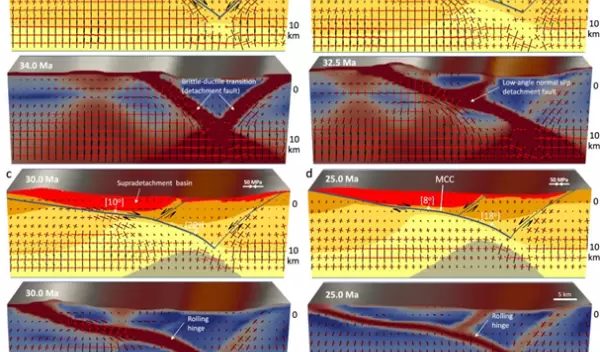
Gravitational forces deep in Earth impact landscape evolution
Research led by Stony Brook University scientists focuses on the interplay among the evolution of the landscape, climate and fossil record of mammal evolution, and mammal diversification in the Western U.S.
A little explored aspect of the research is the connection between gravitational forces deep in the Earth and landscape evolution. Now, in a U.S. National Science Foundation-supported paper in Nature Communications, the researchers show through computer modeling that deep roots under mountain belts (analogous to the massive ice below the tips of icebergs) trigger dramatic movements along faults. These movements ultimately result in collapse of the mountain belt and exposure of rocks once some 15 miles below the surface.
The origin of these exposures, called metamorphic core complexes, has been debated in the scientific community. The study's findings may alter the way scientists attempt to uncover the history of Earth as an evolving planet.
"This research explores how landscapes are shaped by a balance of forces from above and below, by climate and by processes acting miles beneath the Earth's surface, and how changing landscapes have shaped the course of mammal evolution in western North America," says Candace Major, a program director in NSF's Division of Earth Sciences. "It's an example of the complexity of Earth system science, and how seemingly isolated processes are in fact intrinsically connected."
Lead scientist William Holt at Stony Brook, first author Alireza Bahadori at Columbia University and their colleagues found that the core complexes are fossil signatures of past mountain belts in the Western U.S. In the distant past, they occupied regions near Phoenix and Las Vegas, and left traces in the form of gravel deposits from ancient northward and eastward flowing rivers. Today, those traces are located south and west of Flagstaff, Arizona.
The work builds on research also published in Nature Communications in August 2022. Holt and colleagues developed a first-of-its-kind model in three dimensions to illustrate the link between climate and tectonics. They simulated the landscape and erosion/deposition history of the region before, during and after the formation of metamorphic core complexes.
